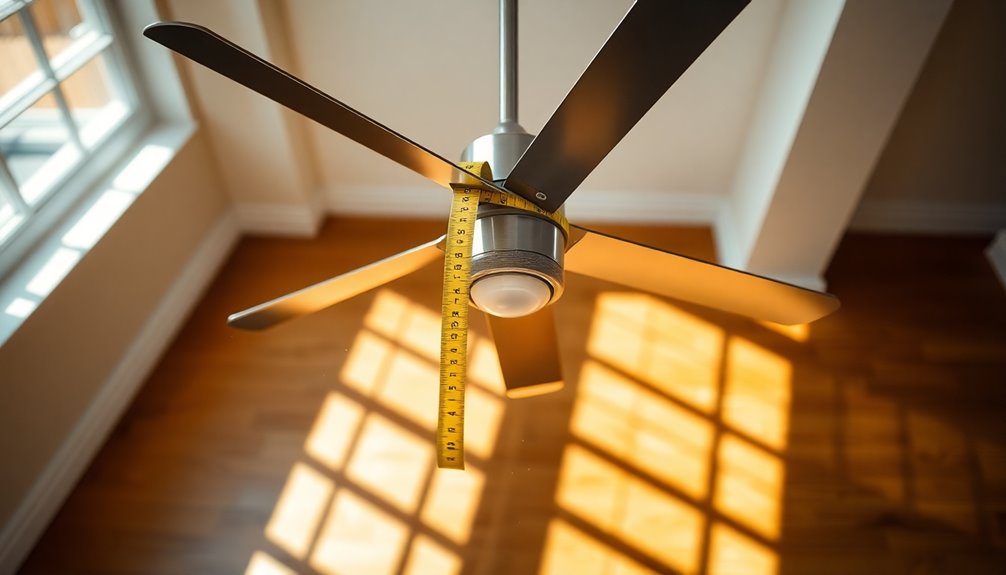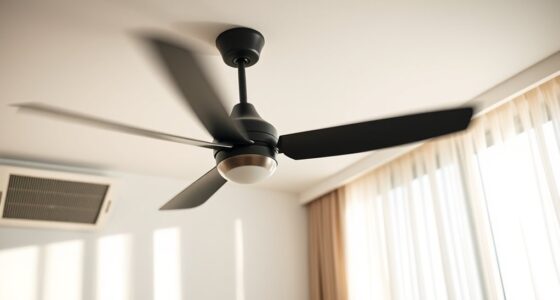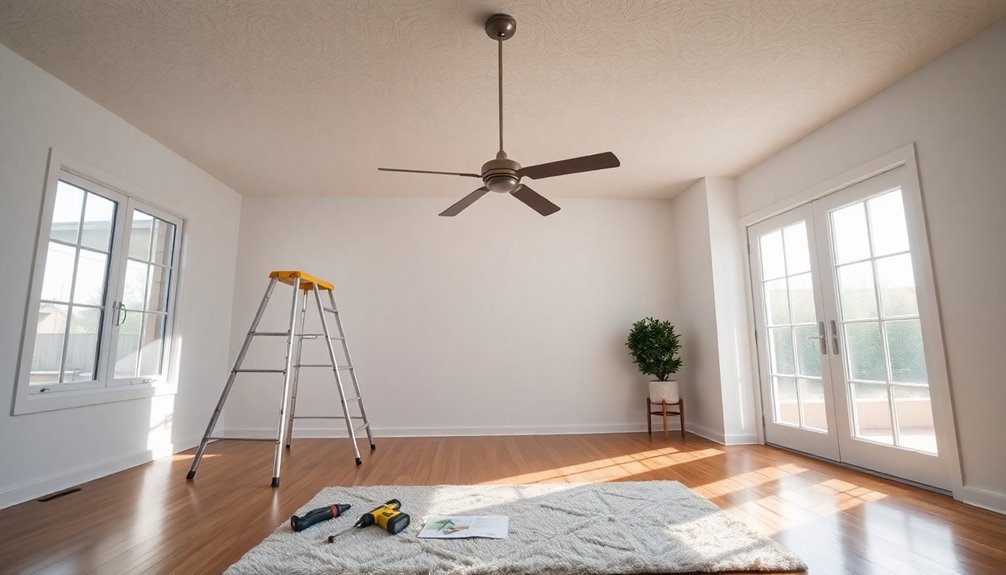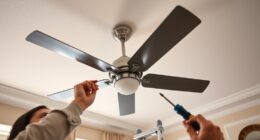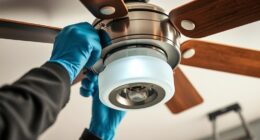Reversing a ceiling fan changes its airflow direction, which can help you maintain comfort and save on energy costs. In winter, setting the fan to spin clockwise pulls warm air down, keeping your space cozy and potentially reducing heating bills by up to 10%. For summer, switch it to counterclockwise to create a rejuvenating breeze, making you feel cooler without cranking up the air conditioner. This simple adjustment can balance room temperatures, ensuring efficient air circulation year-round. If you're interested in maximizing your fan's benefits, there's more to uncover about its usage and maintenance.
Key Takeaways
- Reversing a ceiling fan changes airflow direction to improve comfort during different seasons.
- In winter, clockwise rotation redistributes warm air, enhancing comfort and reducing heating costs by up to 10%.
- In summer, counterclockwise rotation creates a wind-chill effect, allowing for thermostat adjustments and less reliance on air conditioning.
- Proper fan reversal ensures balanced room temperatures year-round, promoting energy efficiency and comfort.
- Most ceiling fans feature an easy switch mechanism for simple seasonal adjustments.
Benefits of Reversing Fans

Reversing your ceiling fan brings significant benefits that enhance your home's comfort and energy efficiency. By changing the direction of your ceiling fan to clockwise during winter, you can effectively push warm air that's risen to the ceiling back down into your living space. This simple adjustment not only improves your comfort but can also reduce heating costs by up to 10%.
In the warmer months, running your fan counterclockwise creates a cool wind-chill effect, helping you feel cooler and allowing you to raise your air conditioner settings. This can lead to significant savings on your energy bills.
Moreover, properly adjusting the fan direction according to the season contributes to balanced room temperatures, ensuring your space feels just right year-round.
With ceiling fans consuming approximately 60 watts compared to the 3,500 watts used by air conditioners, it's clear that utilizing fans can help you save money on energy costs.
Most ceiling fans come with an easy switch mechanism, making it simple to change the direction of airflow. This allows you to tailor your fan's performance to your seasonal needs effortlessly.
Energy Savings Potential

Reversing your ceiling fan can lead to significant energy savings in your home.
By redistributing warm air in winter and enhancing cooling in summer, you can lower heating costs and reduce reliance on air conditioning.
This not only cuts down on your energy consumption but also boosts the efficiency of your HVAC system.
Reduced Energy Consumption
How can a simple adjustment to your ceiling fan lead to significant energy savings? By reversing your ceiling fan, you can optimize the flow of warm air that naturally rises to the ceiling.
In winter, setting your fan to spin clockwise pushes that warm air downward, effectively maintaining a comfortable room temperature without relying heavily on your heating system. This can result in reduced energy consumption, saving you up to 10% on heating costs.
Ceiling fans only consume about 60 watts, a stark contrast to air conditioners that use around 3,500 watts. Using your ceiling fan in winter allows you to keep your thermostat set lower while still feeling warm and cozy.
By operating the fan at a low speed, you boost heating efficiency and maximize the warm air circulation throughout the room.
The simple act of reversing your ceiling fan's direction can lead to long-term savings on energy bills. This efficient air movement reduces your reliance on HVAC systems for heating, ultimately enhancing your home's energy efficiency.
Lower Heating Costs
Making a simple adjustment to your ceiling fan can lead to noticeably lower heating costs. By reversing your ceiling fan to run clockwise during winter, you help redistribute warm air that has accumulated near the ceiling. This simple change creates a more consistent room temperature, allowing your heating system to work more efficiently.
When warm air circulates at lower levels, your thermostat can register the increased temperature faster, which may save you up to 10% on heating costs. With ceiling fans operating on a low, clockwise setting, you enhance thermal comfort without creating drafts, making it an effective solution for winter heating.
Moreover, using ceiling fans in winter complements your heating system, reducing the runtime of your heating appliances. Less time running means decreased energy consumption, which translates to long-term energy savings and reduced reliance on central heating.
Incorporating this small adjustment into your winter routine not only makes your home feel warmer but also helps your wallet.
Enhanced HVAC Efficiency
Ceiling fans play an essential role in enhancing HVAC efficiency and maximizing energy savings. By reversing your ceiling fan to clockwise during winter, you can effectively push warm air down from the ceiling. This simple adjustment can potentially reduce your heating costs by up to 10%.
When you maintain effective air movement throughout your home, it creates a consistent room temperature, which reduces your reliance on heating systems.
With a ceiling fan circulating air, you can comfortably raise your thermostat settings. This means your heating system doesn't have to work as hard, leading to lower overall energy consumption. In fact, ceiling fans consume only about 60 watts, compared to a staggering 3,500 watts for air conditioners.
The long-term savings from consistently using ceiling fans are significant, as they provide a cost-effective solution for enhanced HVAC efficiency. By integrating ceiling fans into your home's climate control strategy, you can enjoy comfortable temperatures year-round while minimizing energy expenditure.
Mechanism of Fan Reversal

When you reverse your ceiling fan, you change the airflow direction to match the season.
In winter, the clockwise rotation creates an updraft that helps distribute warm air, while the counterclockwise motion in summer pushes cool air down for a revitalizing breeze.
This simple adjustment not only enhances your comfort but also promotes energy efficiency year-round.
Airflow Direction Change
The mechanism of reversing a ceiling fan is straightforward yet crucial for maximizing comfort year-round. When you switch the fan's direction, you initiate an airflow direction change that markedly affects your indoor climate.
In summer, the fan typically spins counterclockwise, pushing cool air down and creating a wind-chill effect that makes you feel cooler without changing the room's actual temperature. This is especially welcome on hot days when you want to feel refreshed.
In winter, reversing the fan to a clockwise spin is just as essential. This motion pulls warm air, which naturally rises and collects near the ceiling, back down into your living space. By redistributing that warm air, you can maintain a cozy atmosphere while potentially lowering your heating costs.
Most ceiling fans come equipped with a simple switch for changing rotation direction, making it easy to adapt to seasonal needs.
Seasonal Comfort Adjustment
Adjusting your ceiling fan's direction is key to achieving seasonal comfort in your home. By reversing a ceiling fan, you can make essential seasonal adjustments that enhance your living space.
In the summer, set the fan to spin counterclockwise to create a cooling wind-chill effect. In winter, switch it to clockwise to push warm air down from the ceiling, ensuring an even temperature throughout the room.
Here are some benefits of this simple adjustment:
- Enhanced Comfort: The clockwise rotation redistributes warm air, eliminating cold spots and drafts.
- Energy Savings: Running your fan in winter can cut heating system runtime and costs by up to 10%.
- Easy Operation: Most fans come with a switch to change direction effortlessly, making adjustments a breeze.
- Additionally, using ceiling fans in conjunction with a high-performance heat pump can optimize energy efficiency in your home.
Importance of Fan Size

Choosing the right size ceiling fan for your room is essential for achieving ideal air circulation and energy efficiency. To maximize both, you need to verify that your fan size is proportional to your room dimensions.
For average-sized rooms, a standard fan size of 44 inches typically works well, while larger spaces may require fans ranging from 50 to 54 inches.
If your fan is oversized or undersized, it can lead to inefficiencies and increased energy costs. An improperly sized fan won't effectively circulate air, making it harder to maintain consistent temperatures and overall comfort levels.
Proper fan sizing enhances airflow, allowing you to enjoy a more pleasant environment without overworking your HVAC systems.
Winter Operation Guidelines

When it comes to maximizing your ceiling fan's effectiveness during colder months, adjusting the blade direction is key. To keep your space cozy, you'll want to set your fan to rotate clockwise when viewed from below. This motion creates an updraft, pushing warm air down from the ceiling and helping to maintain a consistent temperature throughout the room.
Here are some winter operation guidelines to help you get the most out of your ceiling fan:
- Run at Low Speed: Operating your fan on a low speed enhances comfort without causing any uncomfortable downdrafts.
- Save on Heating Costs: Running your fan in winter can help you save up to 10% on heating costs by reducing the need for your heating system.
- Regular Direction Changes: Remember to change the fan's direction seasonally to guarantee peak performance and energy efficiency throughout the year.
Summer Operation Guidelines

To keep your home comfortable during the hot summer months, it's essential to set your ceiling fan to rotate counterclockwise. This counterclockwise rotation creates a revitalizing breeze that enhances the cooling effect, making you feel cooler without actually lowering the room temperature.
When your fan works in this direction, it pushes cool air directly downwards, effectively lowering your perceived temperature.
To maximize comfort, operate your ceiling fan on a higher speed setting during summer. This increases airflow and enhances the wind-chill effect, helping you stay cool even on the hottest days.
Additionally, using your ceiling fan in conjunction with your air conditioning can lead to significant energy savings—up to 30%. By raising your thermostat a few degrees while the fan runs, you reduce your reliance on air conditioning, saving you money on energy bills.
Changing Fan Direction

Changing the direction of your ceiling fan is a simple yet effective way to enhance your home's comfort throughout the year. By adjusting the spin of your fan blades, you can maximize airflow based on the season.
In summer, set your fan to spin counterclockwise to push cool air down. In winter, switch it to spin clockwise, which creates an updraft that pulls warmer air down from the ceiling.
Here are a few benefits of changing the direction of your ceiling fan:
- Enhanced heating efficiency: The clockwise spin helps redistribute warmer air trapped near the ceiling.
- Energy savings: Running your fan in the correct direction can save you up to 10% on heating costs during winter.
- Improved comfort: Proper air circulation can make your home feel more comfortable year-round.
Most ceiling fans come with an easy-to-use switch, usually found on the motor housing or remote control.
Familiarizing yourself with this switch can lead to ideal air circulation and contribute to overall energy efficiency, ensuring your home remains cozy and inviting no matter the season.
Maintenance Tips

Proper maintenance is crucial for keeping your ceiling fan running efficiently and extending its lifespan. Start by regularly cleaning the blades to prevent dust buildup, which can reduce airflow and efficiency by up to 20%. A quick wipe with a damp cloth every few weeks can make a big difference.
Next, inspect and tighten any loose screws or fixtures to guarantee peak performance. This step decreases the risk of noise or wobbling during operation, making your fan more enjoyable to use.
Consider scheduling seasonal maintenance checks to verify proper fan direction and functionality before the summer and winter months.
Additionally, lubricate the fan motor as per the manufacturer's recommendations to maintain smooth operation. This simple task can greatly extend your fan's lifespan.
Finally, if you notice any damaged or worn-out pull chains or switches, replace them promptly. This guarantees convenient and safe operation of your ceiling fan, especially when you need it to circulate warm air in the winter months.
Professional Assistance Options

After ensuring your ceiling fan is well-maintained, you might contemplate seeking professional assistance for enhanced performance. Engaging HVAC technicians can considerably improve your fan's efficiency and comfort levels throughout the year. They can provide expert guidance on the correct fan direction for different seasons, ensuring you maximize energy efficiency.
Here are a few professional assistance options to contemplate:
- Professional Consultations: HVAC experts can educate you on fan size, placement, and rotation for ideal air circulation.
- Seasonal Adjustments: Companies like Lozier Heating and Cooling offer services to set your fan's rotation correctly for summer and winter.
- Identifying Unique Challenges: Professionals can spot any HVAC system issues that might affect your ceiling fan's performance and efficiency.
Regular maintenance from HVAC technicians not only enhances the lifespan of your ceiling fan but also boosts the effectiveness of your heating and cooling systems. Additionally, understanding the impact of energy efficiency can help you make informed decisions about your ceiling fan's operation.
Investing in professional assistance can lead to considerable energy savings and improved comfort in your home, making it a smart choice for any homeowner.
Frequently Asked Questions
Does Reversing a Ceiling Fan Really Work?
You might wonder if reversing a ceiling fan really works. Yes, it does!
By changing the direction, you can enhance comfort in your space. In summer, it creates a cooling breeze, while in winter, it helps circulate warm air that rises to the ceiling.
This simple adjustment can even save you on heating costs. So, don't hesitate to flip that switch and enjoy a more energy-efficient home throughout the year!
Does Reversing a Ceiling Fan Make It Cooler?
Like a gentle breeze on a hot day, reversing a ceiling fan can make your space feel cooler.
When you switch it to counterclockwise, the fan pushes air down, creating a wind-chill effect that enhances your comfort.
While it doesn't actually lower the room temperature, the increased airflow tricks your body into feeling cooler.
What Does the Reverse Switch on a Ceiling Fan Do?
When you use the reverse switch on your ceiling fan, you change the direction of the blades.
This adjustment allows the fan to either push cool air down during summer or circulate warm air in winter.
By switching to clockwise in colder months, you create an updraft that redistributes heat, making your space cozier.
In summer, the counterclockwise motion provides a revitalizing breeze, enhancing comfort while helping you save energy.
Is It Better to Reverse the Fan or Forward the Fan?
When you ponder whether to reverse the fan or keep it forward, think of it like choosing between summer's invigorating breeze and winter's cozy warmth.
In summer, running the fan counterclockwise cools your space, making it more comfortable while cutting energy costs.
Conversely, in winter, switching to clockwise pushes warm air down, enhancing comfort without cranking up the heat.
Ultimately, it's about maximizing your comfort while being energy-efficient throughout the year.
Conclusion
Reversing your ceiling fan is like flipping a switch on comfort. By changing its direction, you can dance between cozy warmth in winter and invigorating coolness in summer. It's a simple tweak that can lead to significant energy savings and a more inviting home. So go ahead, give your fan a spin, and let it whisper the secrets of efficiency and comfort, turning your space into a sanctuary all year round.

